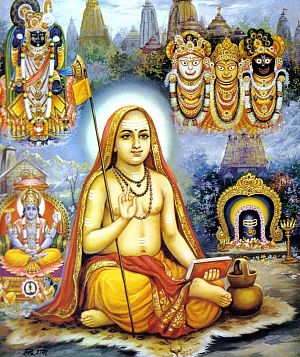News
-
 Pranayama workshop, Mar 1-7
Pranayama workshop, Mar 1-7
-
 21-day Pranayama challenge
21-day Pranayama challenge
-
 Nāda meditation workshop, January 8-12
Nāda meditation workshop, January 8-12
-
 April 3, Navaratri with Yogi Matsyendranath Maharaj, Australia, Queensland
April 3, Navaratri with Yogi Matsyendranath Maharaj, Australia, Queensland
-
 March 17, 2020. Purifiying Pranayama With Yogi Matsyendra Nath
March 17, 2020. Purifiying Pranayama With Yogi Matsyendra Nath
-
 November 2019, Tantra Workshop Series in Argentina
November 2019, Tantra Workshop Series in Argentina
-
 Workshop in Gualeguaychu
Workshop in Gualeguaychu
-
 17-18 November 2018, Yogi Matsyendranath in Źarate (Argentina)
17-18 November 2018, Yogi Matsyendranath in Źarate (Argentina)
-
 15-16 November 2018, Yogi Matsyendranath visit to Uruguay
15-16 November 2018, Yogi Matsyendranath visit to Uruguay
-
 12 Nov 2018, Lecture at USAL (Salvador University)
12 Nov 2018, Lecture at USAL (Salvador University)
-
 10-11 November 2018, Workshops in Quilmes and La Plata (Argentina)
10-11 November 2018, Workshops in Quilmes and La Plata (Argentina)
-
 8 November 2018, Open conference in Necochea (Argentina)
8 November 2018, Open conference in Necochea (Argentina)
-
 2,3,4 November 2018 - Participating in XVI Retreat International of Yoga and Meditation
2,3,4 November 2018 - Participating in XVI Retreat International of Yoga and Meditation
-
 Programme in Québec (Canada) 13-16 June
Programme in Québec (Canada) 13-16 June
-
 Melbourne Book Launch
Melbourne Book Launch
-
 4-years Summer Program
4-years Summer Program
-
 Biography of a Russian Yogi
Biography of a Russian Yogi
-
 November 2017, Visit of Yogi Matsyendranath to Argentina
November 2017, Visit of Yogi Matsyendranath to Argentina
-
 Satsangs of Yogi Matsyendranatha Maharaj in Berlin
Satsangs of Yogi Matsyendranatha Maharaj in Berlin
-
 Seminars and trainings in June-July 2015 (France)
Seminars and trainings in June-July 2015 (France)
Saguna Brahman
Saguna Brahman

The highest reality that possesses qualities (characteristics):
- सगुण, saguṇa – literally means "with the gunas";
- ब्रह्मन्, brahman – "Brahman, the Absolute".
Saguna-brahman is a personified God who creates, supports, and destroys the Universe. He is contrasted with the Nirguna-brahman, highest reality without characteristics, but Нe is the same Brahman.
Saguna-brahman has names and forms, characteristics and attributes for the worshiper. Due to the presence of names and qualities, it is easier for most people to honor the Supreme Reality and meditate on it.
The concept of Saguna-brahman appeared in the early advaita-vedanta. It was actively developed in Shankaracharya’s works, and was first voiced by Dravidacharya (draviḍāchārya), according to researcher Klaus Witz.
Saguna-brahman in advaita-vedanta
Shankaracharya's teaching reflects the main trend of the classical Upanishads. Written by different authors at different times, they do not have a consistent worldview, but Shankara insisted on interpreting them in a single way. He believed that the knowledge of Brahman obtained from the Upanishads should be consistent in all respects, and sought to reconcile different views on the Supreme Reality.
In the early Upanishads, Brahman is described as having qualities, then as not having them. Sometimes both types of definitions are side by side in the same shloka:
द्वे वाव ब्रह्मणो रूपे मूर्तं चैवामूर्तं च, मर्त्यं चामृतं च, स्थितं च यच्च, सच्च, त्यच्च
dve vāva brahmaṇo rūpe mūrtaṃ caivāmūrtaṃ ca, martyaṃ cāmṛtaṃ ca, sthitaṃ ca yacca, sacca, tyacca
"Truly, there are two images of Brahman: embodied and unembodied, mortal and immortal, motionless and moving, existing and true."
"Brihadaranyaka Upanishad" (II, 3, 1)
Shankara offers an explanation, a justification of why one can think about the Absolute in such a different way: the matter is in the activity of cosmic illusion – Maya. In relation to Brahman, Maya acts as his power (Shakti). In relation to the individual, Maya acts as ignorance (avidya). "In fact," Brahman is of no quality (nirguna), impersonal and unchangeable, but refracted in Maya, he "becomes" Saguna-brahman, Ishvara. Maya hides from us the unity of genuine reality and unfolds the imaginary diversity of the world with its subject-object duality (through adhyasa – "superimposing" untrue characteristics on genuine ones, similar to how it happens with the illusory perception of a snake, which is mistaken for a rope).
"From two different points of view, Brahman can be considered both conditioned and unconditioned at the same time. From the point of view of the liberated soul, He is not conditioned; from the point of view of the dependent soul, Brahman must apparently be the cause of the Universe, endowed with omniscience and other attributes."
Shankaracharya
According to Shankara, the existence of Saguna-brahman is illusory, permissible only at the "profane" (व्यावहारिक, vyāvahārika) level of cognition. At the highest (परमार्थिक, paramārthika) level of existence and knowledge, there is only an undifferentiated Nirguna-brahman, which the philosopher defines as Parā. In Madhva’s dvaita and Ramanuja’s vishishta-advaita, on the contrary, Parā, the Supreme reality, is recognized as Saguna-brahman, in the form of Vishnu.
Saguna-brahman in Natha Tradition
The word "kula" ("manifested universe", "life", "world of forms", "body", "family of Gods and Goddesses (Yoginis)", "Bhairava and Bhairavi", "completeness") can be used as a synonym for the concept of "Saguna-brahman".
"The desire to create arises in Shiva, who remains in an unmanifested form during pralaya (dissolution). This desire is revealed through Shakti. In this state, Shiva is called saguna ("possessor of attributes"). Shiva and Shakti are respectively designated as Akula and Kula and their difference is incomprehensible."
"The above-mentioned Shakti is conscious, unlike the unconscious Maya of Vedanta; Shakti of conscious Shiva herself becomes conscious. So, this phenomenal world is a manifestation of conscious Shakti. <...> When He [Shiva] is deprived of action, He is nirguna. When He acts, He is saguna. The fusion of the basis of saguna and nirguna constitutes the nature of Natha. Natha is beyond saguna and nirguna, beyond dvaita (duality) and advaita (non-duality)."
Suresh Chandra Banerjee

